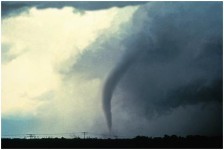Widgetized Section
Go to Admin » Appearance » Widgets » and move Gabfire Widget: Social into that MastheadOverlay zone
When Disaster Strikes: Challenges for the Public HR Professional
A note for our readers: the views reflected by the authors do not reflect the views of ASPA.
By Joe Jarret
 In most public sector disaster response standard operating procedures (SOPs) there exists lists of key personnel. As you would imagine, such lists contain the identity of disaster management players such as the chief executive, first responders, firefighters, rescue workers, law enforcement, etc. One often overlooked, yet essential player in pre and post-disaster scenarios, and throughout the disaster itself, is the HR professional. Merely because an entity is in “disaster mode” does not mean the day to day rules and regulations that govern the conduct of public service don’t apply. Although many states allow certain public sector employment rules to be “relaxed” during a disaster, such moratoria end once an entity is back in “normal mode.” Determining what employees are affected and how is often left to the HR manager to sort out.
In most public sector disaster response standard operating procedures (SOPs) there exists lists of key personnel. As you would imagine, such lists contain the identity of disaster management players such as the chief executive, first responders, firefighters, rescue workers, law enforcement, etc. One often overlooked, yet essential player in pre and post-disaster scenarios, and throughout the disaster itself, is the HR professional. Merely because an entity is in “disaster mode” does not mean the day to day rules and regulations that govern the conduct of public service don’t apply. Although many states allow certain public sector employment rules to be “relaxed” during a disaster, such moratoria end once an entity is back in “normal mode.” Determining what employees are affected and how is often left to the HR manager to sort out.
Regardless of the fact that employees’ priorities shift when disaster strikes, they expect to be paid and have their benefits accrue even if they don’t have access to their assigned work sites. Enter the HR manager. The Society for Human Resource Management (SHRM) recommends, “The role of human resources in disaster and operations continuity planning must be considered in a comprehensive, analytical manner and be linked to the organization’s strategic disaster management plan.” One aspect of disaster preparedness that directly affects the HR manager is the myriad employment laws in the public workplace, especially when it comes to pay and benefits. These laws include the Fair Labor Standards Act in the context of reduced pay and work hours. SHRM provides an insightful look into this dilemma:
Nonexempt employees. The Fair Labor Standards Act (FLSA) requires employers to pay nonexempt employees only for hours that the employees have actually worked. Therefore, an employer is not required to pay nonexempt employees if the employer is unable to provide work to those employees due to a natural disaster.
An exception to this general rule exists where there are employees who receive fixed salaries for fluctuating workweeks. These nonexempt employees have agreed to work an unspecified number of hours for a specified salary. An employer must pay these employees their full weekly salary for any week in which any work was performed.
Exempt employees. For exempt employees, an employer will be required to pay the employee’s full salary if the worksite is closed or unable to reopen due to inclement weather or other disasters for less than a full workweek. However, an employer may require exempt employees to use allowed leave for this time.
Exempt employee chooses to stay home because of weather. The U.S. Department of Labor (DOL) considers an absence caused by transportation difficulties experienced during weather emergencies, if the employer is open for business, as an absence for personal reasons. Under this circumstance, an employer may place an exempt employee on leave without pay (or require the employee to use accrued vacation time) for the full day that he or she fails to report to work. If an employee is absent for one or more full days for personal reasons, the employee’s salaried status will not be affected if deductions are made from a salary for such absences.
However, a deduction from salary for less than a full-day’s absence is not permitted, although the employer may make a partial day time deduction from the employee’s leave bank (if there is insufficient time in the leave bank, no deduction from salary can be made).
Caution is recommended, however, in docking salaried employees’ pay. Moreover, many employers instead require employees to “make up” lost time after they return to work, which is permissible for exempt employees. This practice is not allowed for nonexempt employees, who must be paid overtime for all hours worked more than 40 in a workweek.
Another challenge concerns the hiring of temporary disaster relief workers. The federal government, as well as most states, provide for the hiring of emergency relief workers under a streamlined process that would be considered unlawful in normal mode. Despite the fact that hiring rules are relaxed, the HR manger must nevertheless insure that temporary workers are not retained in a slipshod, reckless manner. Further, senior management needs to be reminded that “relaxed rules” does not mean “no rules.”
Summary:
The HR director is an important and integral player in the disaster scenario and one that should be included in an entity’s strategic disaster management plan at all stages of a disaster.
Author: Joe Jarret is a public sector manager, attorney and mediator who lectures on behalf of the Master of Public Policy and Administration program in the Department of Political Science at the University of Tennessee, Knoxville. He is the 2013-2014 president of the E. Tennessee Chapter of ASPA.


Follow Us!